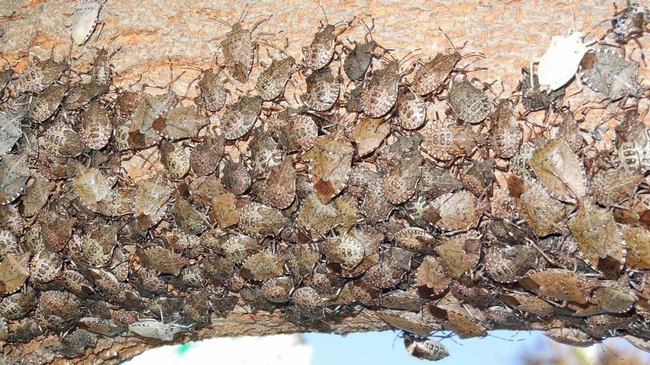
Ingels said he had no difficulty finding the pests on tree foliage and flying around when he visited the site last week.
“This is one of the worst invasive pests we’ve ever had in California,” Ingels said.
Brown marmorated stink bug affects many different crops and is a serious residential problem. It moves around easily, so can be expected to spread. It can fly up to a half mile at a time and also travels long distances by hitching rides in vehicles or inside furniture or other articles when they are moved, often during winter months. As a result, most new infestations are found in urban areas.
Brown marmorated stink bugs are native to China, Japan and Korea. They were first documented in the United States in Pennsylvania in 2001, but was likely established there several years earlier. The pest has spread throughout Pennsylvania, is believed to be established in at least 15 states, and has been found occasionally in more than a dozen additional states. In 2004, BMSB made its way to Oregon and is now established in northwest Oregon and a portion of Southern Washington. The National Agricultural Pest Information System maintains a map showing current infestations, but it does not yet show California finds. The pest has been present in Los Angeles County for 6 years.
BMSB feeds on dozens of California crops, including apples, pears, cherries, peaches, melons, corn, tomatoes, berries and grapes. Feeding on fruit creates pock marks and distortions that make the fruit unmarketable. In grapes, berries collapse and rot increases. Wine tasters have been able to detect stink bug odor in wines made from grapes that had 10 bugs in a 35-pound lug. It is also a pest of many ornamentals, especially the fruit-bearing trees, princess tree (Paulownia tomentosa), common Catalpa (Catalpa bignonioides) and tree-of–heaven (Ailanthus altissima).
In addition to the damage caused by the BMSB feeding, the “true bug” can cause disturbing problems for homeowners in the winter. When the weather cools down, bugs migrate in droves to sheltered areas, including inside homes and buildings.
“These bugs aggregate in such numbers that there are reports of people using manure shovels and five-gallon buckets to dispose of them,” Ingels said. “The strong, unpleasant odor the insects emit when disturbed makes cleanup still more daunting.
BSMB is a pest in its homeland, but is mostly controlled by parasitic wasps. USDA researchers have collected parasitic wasps in Asia, but they must be tested extensively before they can be released in California, a process that will take until 2016.
“Parasitism is our best hope for reducing populations,” Ingels said. “Chemical control of BMSB is very challenging.”
Ingels said the best way to keep them out of homes is to exclude them by sealing off any potential entry points, especially around window air conditioning units. Insecticides that have been shown to be effective in the lab are often less effective in the field. In and around the home, insecticides that have efficacy are mostly pyrethroids and neonicotinoids, both of which can have harmful off-site effects.
Pesticides showing efficacy on farms also include organophosphates and carbamates. But growers have worked hard to develop effective Integrated Pest Management programs, and the use of these broad spectrum sprays will set these programs back. There are also pest resistance concerns with increasing use of these products.

“Because they are strong fliers, it’s just a matter of time before they reach farms,” Ingels said.
The pest can be distinguished from ordinary brown stink bugs by its larger size, marble-like coloring on its shield and white markings on the extended edge of the abdomen. BSMB also has distinctive white bands on the antennae and legs. The UC Integrated Pest Management Program has posted a video on YouTube to aid in identifying the pest. (The video is also embedded below.)
Traps with sex pheromones or other attractants can be used to monitor for the pest, but they are often poor at trapping the bugs even when populations are high. The best monitoring method is to inspect foliage throughout the year, and larger branches in late summer and fall for aggregating bugs. A quick method is to beat foliage over a piece of cardboard or sheet. If suspected BSMB are found, place some in a container and note where and when they were collected. Take the sealed container to the county agricultural commissioner or local UC Cooperative Extension office.
The following UC IPM video was created to help identify brown marmorated stink bug: